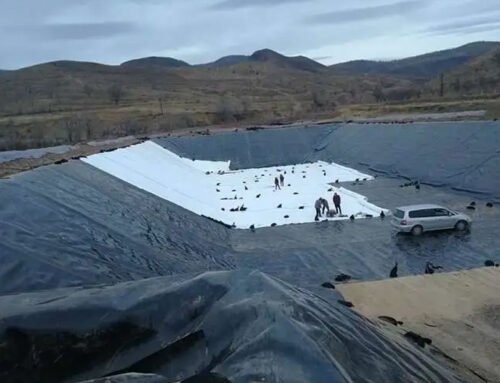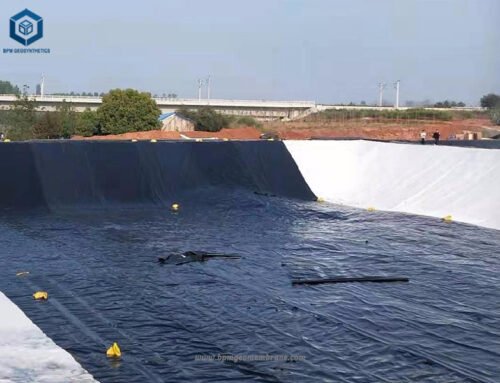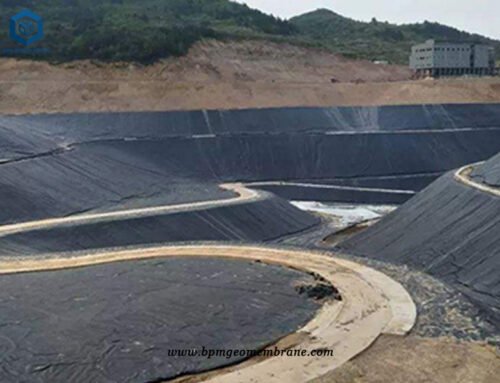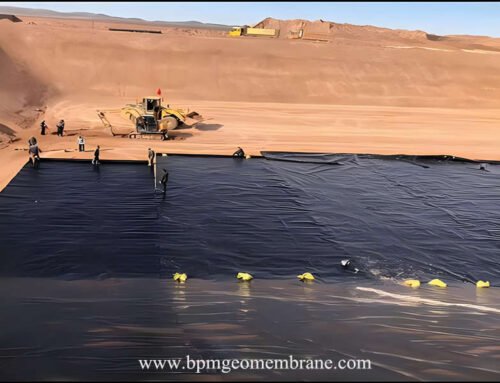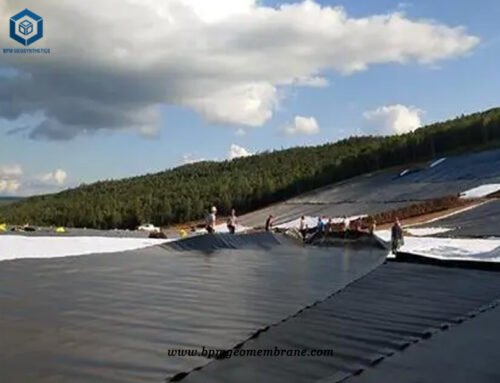PVC Geomembrane, also knwon as PVC liner, is made with high quality polyvinyl chloride resin as the raw material, adding carbon black, anti-aging agent, antioxidant and other auxiliary materials. BPM PVC geomembrane adopts advanced production equipment and multilayer extrusion blow molding technology. Our PVC geomembranes is widely used in landfills, sewage treatment ponds and tailings anti-seepage projects to protect the soil, groundwater and atmospheric environment from long-term corrosion and infringement of tailings and effectively protect the environment. Compared with PVC Geomembrane, HDPE geomembrane liner has absolute advantages in fishery breeding, agricultural dam pond liner, landfill liner and other waterproof applications.
1. What Is PVC Geomembrane for Tailings Dam Project?
PVC geomembrane is a synthetic liner made from polyvinyl chloride (PVC) material that is commonly used in tailings dam projects. It serves as an impermeable barrier to prevent the seepage of liquids and gases. PVC geomembranes are highly versatile and find applications in environmental engineering, civil engineering, and geotechnical projects.
Manufactured using PVC resin, plasticizers, stabilizers, and additives, PVC geomembranes can be tailored to meet the specific requirements of tailings dam projects. They are available in various thicknesses, widths, and textures. Smooth PVC membranes are easy to install and are commonly used in reservoirs, ponds, and secondary containment systems. Textured PVC geomembranes, with their anti-slip surface, are ideal for landfill liners and exposed geomembrane covers where increased friction is needed.
PVC geomembranes are known for their durability, long service life, and low maintenance requirements. They are resistant to punctures, tears, and environmental degradation. These geomembranes possess high tensile strength, flexibility, and dimensional stability, enabling them to withstand ground movement and temperature variations.
In tailings dam projects, PVC geomembranes provide reliable containment and barrier solutions to prevent the seepage of potentially harmful substances. They are cost-effective and offer superior performance, making them a popular choice in the geosynthetic industry.
Overall, PVC geomembranes in tailings dam projects provide effective protection against seepage, ensuring the environmental safety and integrity of the storage facility.
2. What Are The Advantages of PVC Geomembrane for Tailing Dam project?
PVC geomembranes provide effective containment and protection in tailings dam projects. They offer efficient installation, reliable seam integrity, and flexibility to withstand challenging conditions, contributing to the overall success and safety of the project.
2.1 Fast Subgrade Coverage
PVC geomembranes allow for quick installation and coverage of the subgrade. This helps expedite the construction process and saves time and labor.
2.2 Factory Quality Seams
PVC geomembranes can be wedge welded on-site, ensuring high-quality seams that are as strong and reliable as those made in a factory setting. This welding technique minimizes the chances of leakage and provides a secure barrier against seepage.
2.3 High Flexibility
PVC geomembranes exhibit high flexibility, making them suitable for deployment even in windy conditions. Their ability to conform to the terrain and adapt to ground movement ensures proper coverage and containment, reducing the risk of failure.
2.4 Range of Thickness Options
PVC geomembranes are available in various thickness options, including 20, 30, 40, 50, 60, 80, and 100 mil. This range allows tailings dam projects to choose the appropriate thickness based on the specific requirements and environmental conditions, ensuring optimal performance and longevity.
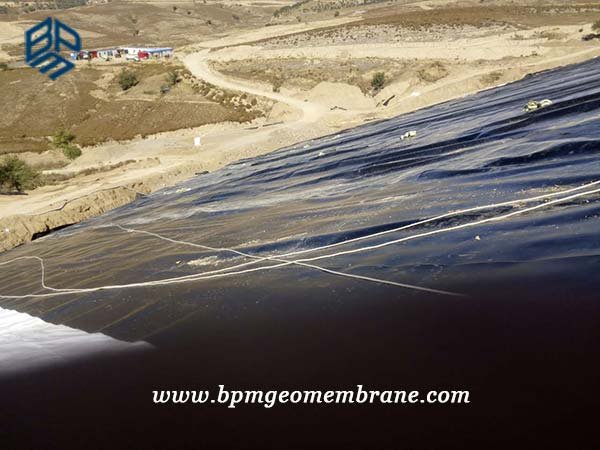

3. What Is The Difference Between HDPE And PVC geomembrane?
The main difference between HDPE and PVC geomembrane lies in their material properties and performance characteristics.
HDPE geomembranes are known for their excellent resistance to UV radiation, oxidation, chemical reactions, as well as their tear and puncture resistance. They are typically welded together using specialized welding machines, resulting in strong and reliable seams. This welding process significantly reduces the chances of leakage and seepage, making HDPE geomembranes highly effective for containment applications.
On the other hand, PVC geomembranes are flexible and relatively easy to handle. However, they are less resistant to UV radiation compared to HDPE geomembranes. PVC geomembranes can exhibit flexibility, allowing for easier installation and conforming to irregular surfaces.
In terms of mechanical properties, HDPE geomembranes are tough and non-flexible. They tend to have a sharp peak in their stress-strain curve, resulting in a relatively abrupt failure when subjected to excessive stress. In contrast, PVC geomembranes exhibit a larger amount of elongation before failure, showcasing greater elongation properties.
The choice between HDPE and PVC geomembranes depends on the specific requirements of the project. HDPE geomembranes are preferred for their superior UV resistance, chemical resistance, and tear/puncture resistance, making them suitable for applications where durability and long-term performance are crucial. PVC geomembranes, with their flexibility and ease of handling, are often chosen for projects with less demanding conditions and where elongation properties are important
4. Case Study of PVC Geomembrane for Tailing Dam project in Inner Mongolia
In Inner Mongolia, a customer involved in phosphate concentrate mining faced the challenge of managing a large volume of tailings generated from the production of phosphoric acid. With tens of thousands of tons of phosphate tailings being produced annually, the storage of these tailings in open-air conditions posed significant environmental risks, including land and resource occupation, atmospheric pollution, and potential water contamination. To address these concerns and meet environmental protection requirements, the customer opted to implement a centralized treatment system using PVC geomembrane for anti-seepage measures.
In September 2017, a delegation from the Inner Mongolia Tailings Project Construction Unit visited the BPM factory to explore potential collaboration. The customer was impressed by BPM’s operations, including the high-density polyethylene (HDPE) geomembrane production process, quality of raw materials, and overall product excellence. Recognizing the critical role of anti-seepage measures in the project, the customer selected BPM as their PVC geomembrane supplier.
A supply contract was signed, outlining the terms of the agreement between the customer and BPM. Additionally, a construction service agreement was executed, solidifying the commitment to provide not only the required PVC geomembrane but also construction-related services to support the successful implementation of the Inner Mongolia tailing project.
The PVC geomembrane specified for the project had a thickness of 2mm, and each roll measured 7 meters in width and 34 meters in length. The total demand for the project was 50,000 square meters. To meet the project timeline, BPM committed to delivering the required PVC geomembrane within a two-week period.
The visit and subsequent agreements demonstrated the customer’s confidence in BPM’s expertise and ability to deliver high-quality products and services. This collaboration marked a significant milestone in addressing the specific challenges faced by the Inner Mongolia tailing project, ensuring effective anti-seepage measures and environmental protection.
Through the implementation of PVC geomembrane and the partnership with BPM, the customer in Inner Mongolia aimed to mitigate the environmental impact of their tailings storage, safeguarding the ecological environment and the well-being of local residents.
We dedicated ourselves to completing the production of the PVC geomembrane products as ordered. The logistics department efficiently delivered the qualified geomembrane to the construction site in Inner Mongolia. Our skilled welding workers, with their extensive construction experience, were promptly dispatched to the site. Through close collaboration with our partners, we achieved success after an intense month of work, with the project meeting all the requirements of third-party testing. The customer expressed great satisfaction with our expertise, execution of the PVC geomembrane products, and the overall contract process. As a result, we initiated further communication and discussions for another tailings disposal project scheduled for the following year.
5. About BPM Geomembrane
BPM Geomembrane is a leading professional geomembrane manufacturer. Our geomembrane products are exported to over 81 countries and regions. Our products are widely used in water conservancy, environmental protection, municipal engineering, aquaculture, sewage treatment, tailings anti-seepage, landfills, landscape and water conservancy projects. Welcome to visit our factory.
If you have any questions or inquiries, please contact us, we will reply as soon as possible.

